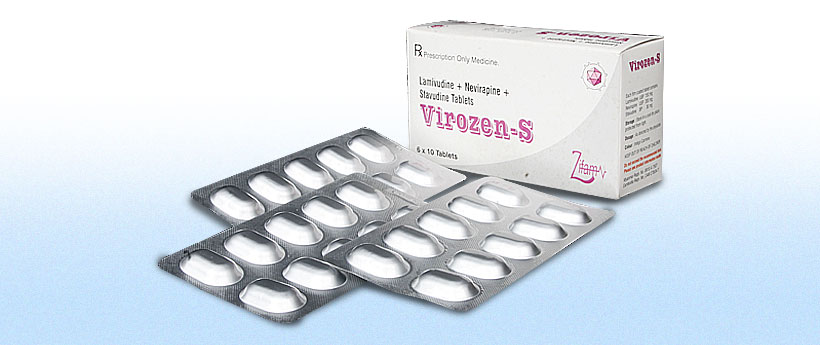Virozen S
- ENG
- မြန်မာ

Composition
Each film-coated tablet contains
Lamivudine USP 150mg
Nevirapine USP 200mg
Stavudine BP 30mg
Description
VIROZEN-S is a combination of 3 drugs commonly used in the management of Human Immunodeficiency Virus (HIV) infection. Both stavudine and lamivudine belong to the nucleoside analogue class of antiretrovial drugs. Both drugs act by terminating the growth of the DNA chain and inhibiting the reverse transcriptase of HIV. Nevirapine is a non-nucleoside reverse transcriptes inhibitor. It acts by directly inhibiting reverse transcriptase.
Indications
VIROZEN-S is indicated for the treatment of HIV infection, once patients have been stabilized on the maintenance regimen of nevirapine 200mg bd, and have demonstrated adequate tolerability to nevirapine.
Dosage and Administration
Adults
VIROZEN-S 1 tablet twice daily for patients weighing < 60 kg
VIROZEN-S should not be administered to patients who have just initiated therapy with nevirapine. This is because an initial lead-in dosing of 200 mg nevirapine once daily for 2 weeks is recommended. Following this lead-in dose, a dose escalation (maintenance dose) to 200mg nevirapinebd may be carried out in the absence of any hypersensitivity reactions (e.g. rash, liver function test abnormalities; see Warnings and Precautions).
Dosage Adjustment: Because it is a fixed-dose combination, VIROZEN-S should not be prescribed for patients requiring dosage adjustment, such as those with low body weight (<50 kg).
Patients who interrupt nevirapine dosing for more than 7 days should restart the recommended dosing, using one 200 mg Nevimune tablet daily for the first 14 days (lead-in) in combination with the other antiretrovirals, followed by 200mg twice daily using VIROZEN-S in the absence of any signs of hypersensitivity.
No data are available to recommend a dosage of nevirapine in patients with hepatic dysfunction, renal insufficiency or undergoing dialysis.
Contraindications
VIROZEN-S is contraindicated in patients with clinically significant hypersensitivity to any of the components contained in the formulation.
VIROZEN-S is also contraindicated for patients who are just initiating therapy with nevirapine. These patients require a lead-in dose of nevirapine 200 mg o.d., whereas this formulation contains the maintenance dose of nevirapine 200 mg b.d. (see Indications).
Warnings and Precautions
Lactic acidosis/severe hepatomegaly with steatosisLactic acidosis/severe hepatomegaly with steatosis, including fatal cases, have been reported with the use of antiretroviral nucleoside analogues alone or in combination, including stavudine and lamivudine.
Peripheral neuropathy Stavudine therapy can be associated with severe peripheral neuropathy, which is dose-related and occurs more frequently in patients with advanced HIV infection or who have previously experienced peripheral neuropathy.
Patients should be monitored for the development of neuropathy that is usually characterized by numbness, tingling or pain in the feet or hands. Stavudine-related peripheral neuropathy may resolve if therapy is withdrawn promptly. In some cases, symptoms may worsen temporarily following discontinuation of therapy.
If symptoms resolve completely, resumption of treatment may be considered using the following dosage schedule for adults:
Stavudine 20 mg twice daily for patients > 60kg Stavudine 15 mg twice daily for patients < 60kg.
In this case, therapy with VIROZEN-S is no longer appropriate.
Patients with HIV and hepatitis B virus coinfection: In clinical trials, some patients with HIV infection who have chronic liver disease due to hepatitis B virus infection experienced clinical or laboratory evidence of recurrent hepatitis upon discontinuation of lamivudine. Consequences may be more severe in patients with decompensated liver disease.
Hypersensitivity reactions Severe, life-threatening skin reactions, Stevens-Johnson syndrome, toxic epidermal necrolysis, and hypersensitivity reactions.Severe or life-threatening hepatoxicity, impaired renalor liver function, Pregnancy and lactation.
Drug Interactions
Lamivudine Trimethoprim 160mg/sulphatmethoxazole 800 mg once daily has been shown to increase lamivudine exposure (AUC)
Nevirapine Rifampin/Rifabutin, Ketoconazole, Oral Contraceptives, Methadone.
Impaired renal function of the dosage of both stavudine and lamivudine is required in patients with a creatinine clearance of 50ml/min or less. Hence, VIROZEN-S cannot be used in this patient population. There are no data available on dosage in patients with renal insufficiency or undergoing dialysis.
Pregnancy: Lamivudine, Stavudine and nevirapine are all classified under category C. There are no adequate and well-controlled studies in pregnant women. VIROZEN-S should be used during pregnancy only if the potential benefits outweigh the potential risk.
Lactation:It is recommended that HIV -infected mothers do not breast-feed their infants to avoid risking postnatal transmission of HIV infection. It is not known whether stavudine or lamivudine are excreted in human milk. Nevirapine is present in breast milk.
Paediatrics: VIROZEN-S is not intended for use in paediatric patients.
Side Effects:Lamivudine Pancreatitis, Lactic acidosis and hepatic steatosis, hepatits and liver failure diarrhea, malaise and fatigue, headache, nausea and vomiting, abdominal pain and discomfort, peripheral neuropathy, arthralgias, myalgias, skin rash, pruritus, transient neutropenia and thrombocytopenia and rarely, pancreatitis.
Stavudineperipheral neuropathy, Lactic acidosis and hepatitis steatosis, hepatitis and liver failure Rash, diarrhoea, nausea/vomiting, pancreatitis, dementia and other peripheral neurologic symptoms have also been associated with the use of stavudine.
Nevirapinerash and increases in liver function tests, hypersensitivity reactions mild to moderate, maculopapular erythematous cutaneous eruptions





